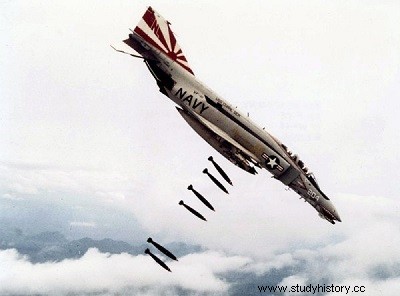
Things went from bad to worse. In 1963 Diem was assassinated, giving way to the Khanh regime. The territory effectively governed by Saigon was reduced to cities, the rest being left to the Vietcong. The Civil Defense Corps and the Civil Guard were often frowned upon by the population.
The Viet Cong fought better than the South Vietnamese troops, which were better armed, better fed and brought by helicopter to the scene of the fighting.
The torrent of dollars poured into Saigon only fueled intrigue and political corruption.
Mao prophesied:"If the war the Americans are waging in Vietnam turns out to be against them, it means that they can be beaten anywhere "
The communists did not realize President Johnson's will to win the war.
The Vietcong attacks on Bien Hoa , Pleiku, and the US base at Da Nang (Tourane) and a US Navy destroyer brought an American response as vigorous as it was unexpected. Air raids were carried out against North Vietnam from aircraft carriers cruising in the Gulf of Tonkin. American tactical forces returned to action at an increasingly high level both against the Vietcong in the south and against strategic objectives in the north.
On March 8, 1965 the Marines landed in Da Nang marking the beginning of the direct engagement of the United States.
A squadron of F105 Thunderchief landed at the same time on a base in Thailand.
IT is absolutely obvious that if the American forces had not intervened the administration of Saigon would have been swept away ten years earlier.
America decided to turn the situation around, and the intensity of the conflict increased. American troops burned four times as much ammunition as in Korea, and only slightly less than the forces engaged in Europe during the years 1944-1945. More than half of the air force consisted of fighter-bombers:the A-1, with its excellent load capacity, autonomy, resistance to damage; the F-100 Super Saber, used both for ground support and for cover hunting; the F-105 which ensured from 1965 to 1968 75% of USAF missions in North Vietnam (and which paid the price); the F-4 Phantom II, a multi-role aircraft, excellent in all missions, whose faults were gradually eliminated (installation of a fixed 20 mm Vulcan cannon, installation of leading edge flaps to improve maneuverability ); the Skyhawk A-4, perhaps the most effective of them all; the A-6 Intruder, the only one capable of hitting a target in all weathers and at night; the new Corsair II A-7, which arrived later in the war, with the Navy and the marines, then with the Air Force (model A-7D) in 1972. These planes ensured the main part of the combat missions during the ten years of American involvement.
